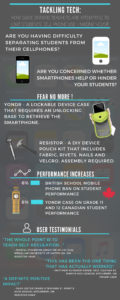I chose to respond to the Tackling Tech article by Nadine Yousif. The article focuses on how technology affects students in Canadian classrooms. While technological devices can be great teaching tools in the classroom, they can also have a strong negative effect on students, causing them to become distracted.
The Globe and Mail article involves Yousif focusing on a couple of teachers at St. Mary’s High School in Kitchener, Ontario. Matthew Acheson, who teaches Grade 11 and 12, and Sean Zister, who teaches Grade 9 geography and religion. The two each use an invention created to prevent students from using their device in the classroom, thus resulting in becoming distracted. While the technological era continues to evolve, Canadian schools and school boards have each adopted their own device policies, exemplifying that technology is seen as more of a hinderance, rather than as help. In hopes of managing this issue, teachers have tried many methods of separating students from their devices including having students place their smartphones in clear boxes at the beginning of class, at the front of the room. While this option is more traditional, there are two new alternatives that can be used to regulate cellphone usage in classroom; the Yondr and Resistor Case.
The Yondr Case, created by Graham Dugoni, is a “specialized pouch that then locks, blocking any access to WiFi and social media apps” (Yousif, 2018) . In order to unlock the case, the student must visit an unlocking base that is controlled by their teacher. Similarly, the Resistor Case, created by University of Waterloo’s Critical Media Lab director Marcel O’Gorman, was created to achieve the same results. The Resistor Case “is designed to hold the students’ devices at their desk for the duration of the class, however it does not lock” (Yousif, 2018). It comes as a Do-It-Yourself kit that includes vinyl, Velcro, nails and duct tape. Since the sound of Velcro is loud and noticeable when ripped apart, its purpose is to make students think a bit harder about reaching for their device, making them understand the idea of self-regulation. Acheson and Zister both found each case to have positive impacts on their students. The Yondr Case caused Acheson’s class average to increase by eight percentage points.
Before engaging with Yousif’s article, I already had a strong sense of annoyance whenever I saw students in my placement trying to hide their cellphones in their lap or desk. After reading this article, I decided to research each case to learn more about how to purchase them. Both brands actually offer packages for schools where the pouches are available in bulk. I personally would like to see these products in more schools across Ontario, as I have noticed technology to be a drawback and distraction in previous placements. If schools across Canada implemented these cases into each classroom the element of distraction could be eliminated, resulting in student success. The article states that Premier Doug Ford has suggest an outright ban on cellphones in schools to “maximize learning time”, similar to the French movement of banning cellphones on school property entirely. I believe a line should be drawn as there are both many pros and cons to having devices in the classroom. While I do not completely agree with a ban altogether, I do believe educators, schools and school boards collectively should have better control on personal devices. To some, I believe they could think cases like Yondr and Resistor are extreme. To me, I believe they are necessary. Educators through the years, and even I in my placements have tried time and time again to separate students from their phones. Traditional methods do not work, these cases are next level inventions that are the answers to our prayers. I am thankful I have been introduced to both the Yonder and Resistor cases, as I had never heard of them prior to reading this article. Yousif’s article got me thinking of introducing the idea of protective device cases in my future classroom, should traditional methods be unsuccessful.
With that in mind, I decided to create an infographic. I wanted to capture the attention of educators and school administration by presenting them with facts and testimonials about each phone case, much like an advertisement would. To create this, I used the infographic template on Canva, and manipulated it to fit my personal liking and design.

